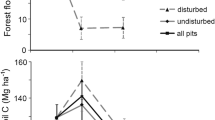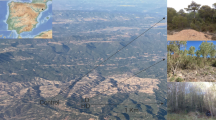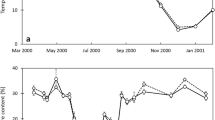Abstract
The short-term impacts of prescribed burning were determined for the physical and chemical properties of a forest soil on a clear-cut in western Newfoundland, Canada. The experimental site was predominantly covered by black spruce trees (Picea mariana Mill.) that were harvested in 1996. In August 1998, prescribed burning removed most of the logging residues left on the site after harvesting, all above-ground surface vegetation, and parts of the upper humus layer. In October 1998, field samples were taken from four replicated burned plots and four replicated unburned plots. In each study plot, soil samples were taken from the organic layer (F+H) and from the top 10 cm of the mineral soil. In the burned treatments, mass of the humus layer (F+H) was reduced by 24% and, because of the accretion of basic ash materials, acidity of the humus layer was also reduced by up to 1 unit. In the organic layer and the mineral soil, total contents of Mg, Ca, and P, extractable Mg and Ca, available P, sum of NH4Cl-extractable cations, and C/N ratios were increased by burning, while total C and N as well as total and extractable K remained unaffected by burning.







Similar content being viewed by others
References
Adams PW, Boyle JR (1980) Effects of fire on soil nutrients in clearcut and whole-tree harvest sites in central Michigan. Soil Sci Soc Am J 44:847–850
Alban DH (1974) Influence on soil properties of prescribed burning under mature red pine. USDA Forest Service Research Paper NC-139. North Central Forest Experiment Station, St. Paul, MM
Båath E, Frostegård Å, Pennanen T, Fritze H (1995) Microbial community strucure and pH response in relation to soil organic matter quality in wood-ash fertilized, clear-cut or burned coniferous forest soils. Soil Biol Biochem 27(2):229–240
Ballard TM (2000) Impacts of forest management on northern forest soils. For Ecol Manage 133(1–2):37–42
Beaton JD (1959) The influence of burning on soil in the timber range area of Lac Le Jeune, British Columbia. II. Chemical properties. Can J Soil Sci 39:6–11
Beese WJ (1992) Third-year assessment of prescribed burning on forest productivity of some coastal British Columbia Sites. FRDA Rep. 181. Cooperative Publication of the B.C. Ministry of Forests and MacMillan- Bloedel Ltd, Canada
Brady NC, Weil RR (1999) The nature and properties of soils, 12th edn. Prentice Hall, Englewood, Cliffs, 882 pp
Brown AA, Davis KP (1973) Forest fire: control and use, 2nd edn. McGraw-Hill, New York, p 671
Cade-Menun BJ, Berch SM, Preston CM, Lavkulich LM (2000) Phosphorus forms and related soil chemistry of Podzolic soils on northern Vancouver Island. II. The effects of clear-cutting and burning. Can J For Res 30(11):1726–1741
Chancey HWR (1958) Changes in the soil following burning. In: Symposium on prescribed burning in forestry, agriculture, and wildlife management. Newfoundland Research Committee, Pub. No.1
Damman WWH (1983) An ecological subdivision of the island of Newfoundland. In: South GR (ed) Monographiae biologicae 48: biogeography and ecology of the Island of Newfoundland. Junk, The Hague, pp 163–206
DeBano LF, Klopatek JM (1988) Phosphorus dynamics of pinyon-juniper soils following simulated burning. Soil Sci Soc Am J 52:271–277
DeByle NV (1973) Soil fertility as affected by broadcast burning following clearcutting in northern Rocky Mountain larch/fir forests. In: Proceedings Montana Tall Timbers Fire Ecology Conference and Fire and Land Management Symposium, vol. 14, pp 441–464
Delaney BB (1974) Land capability classification for forestry in Newfoundland. Newfoundland Forestry Service, Department of Forestry and Agriculture, p 103
DIN ISO 11260, Beuth Verlag, Berlin, Germany
Frey BR, Lieffers VJ, Munson AD, Blenis PV (2003) The influence of partial harvesting and forest floor disturbance on nutrient availability and understory vegetation in boreal mixedwoods. Can J For Res 33(7):1180–1188
Grier CC (1975) Wildfire effects on nutrient distribution and leaching in a coniferous ecosystem. Can J For Res 5:599–607
Grier GC, Cole DW (1971) Influence of slash burning on ion transport in a forest soil. Northwest Sci 45(2):100–106
Harden JW, Neff JC, Sandberg DV (2004) Chemistry of burning the forest floor during the FROSTFIRE experimental burn, interior Alaska, 1999. Global Biochem Cycl 18
Hendricks JH, Wilson CA, Boring LR (2002) Foliar litter position and decomposition in a fire-maintained longleaf pine–wiregrass ecosystem. Can J For Res 32(6):928–941
ISSS-ISRIC-FAO (1998) World reference base for soil resources. FAO, World Soil Resources Report No. 84, Rome, Italy
Johnson DW, Curtis PS (2001) Effects of forest management on soil C and N storage: meta analyses. For Ecol Manage 140:227–238
Johnston M, Elliott J (1998) The effect of fire severity on ash, and plant and soil nutrient levels following experimental burning in a boreal mixedwood stand. Can J Soil Sci 78(1):35–44
Kalra YP, Maynard DG (1991) Methods manual for forest soil and plant analysis. Information Report NOR-X-319, Forestry Canada, North West Region, Northern Forestry Centre, Canada
Lousier JD, Parkinson D (1976) Litter decomposition in a cool temperate deciduous forest. In: Weber MG (ed) (1987) Decomposition, litter fall, and forest floor nutrient dynamics in relation to fire in eastern Ontario jack pine ecosystems. Can J For Res 17:1496–1506
McColl JG (1978) Ionic composition of forest floor solutions and effects of clearcutting. Soil Sci Soc Am J 42:358–363
Meades WJ, Moores L (1994) Forest site classification manual, a field guide to the Damman Forest types of Newfoundland. Western Newfoundland Model Forest, Department of Forestry and Agriculture, Natural Resources Canada, Canadian Forest Service, FRDA Report 003
Pare D, Bergeron Y, Longpre M-H (2001) Potential productivity of aspen cohorts originating from fire, harvesting, and tree-fall gaps, on two deposit types in northwestern Quebec. Can J For Res 31:1067–1073
Pietikainen J, Hiukka R, Fritze H (2000) Does short-term heating of forest humus change its properties as a substrate for microbes? Soil Biol Biochem 32(2):277–288
Rab MA (1996) Soil physical and hydrological properties following logging and slash burning in the Eucalyptus regnans forest of southeastern Australia. For Ecol Manage 84:159–176
Sanscrainte CL, Peterson DL, McKay S (2003) Carbon storage and soil properties in late-successional and second-growth subalpine forests in the North Cascade Range, Washington. Northwest Sci 77(4):297–307
Scheffer F, Schachtschabel P (1992) Lehrbuch der Bodenkunde. Ferdinand Enke Verlag, Stuttgart
Schlichting E, Blume H-P, Stahr K (1995) Bodenkundliches Praktikum, 2 Aufl. Blackwell Wissenschafts-Verlag, Berlin
Smith DW (1970) Concentrations of soil nutrients before and after fire. Can J Soil Sci 50:17–29
Starr M (1985) Prescribed burning and soil acidification. In: Symposium on the effects of air pollution on forest and water ecosystems. Helsinki, Finland. 23–24 April 1985
Steel RGD, Torrie JH (1980) Principles and procedures of statistics: a biometrical approach. McGraw-Hill, Toronto, 633 pp
Taylor SW, Hawkes BC, Silversides RH, Weber MG (1991) Initial effects of prescribed fire and mechanical site preparation on seedling environment and establishment on a backlog NSR site in central interior British Columbia. FRDA Rep. 177. FRDA II, BC, Canada
Viro PJ (1969) Prescribed burning in forestry. Comm Inst Forest Fenn 67(7):1–49
Viro PJ (1974) Effects of forest fires on soil. In: Kozlowski TT, Ahlgren CE (eds) Fire and ecosystems. Academic, New York
Weber MG (1987) Decomposition, litter fall, and forest floor nutrient dynamics in relation to fire in eastern Ontario jack pine ecosystems. Can J For Res 17:1496–1506
Weber MG, Taylor SW (1992) The use of prescribed fire in contemporary Canadian forestry practice. For Chron 68(3):324–334
Weber MG, Flannigan MD (1997) Canadian boreal forest ecosystem structure and function in a changing climate: impact on fire regimes. Environ Rev 5(3–4):145–166
Wein RW, MacLean DA (1983) An overview of fire in northern ecosystems. In: Ross RW, MacLean DA (eds) The role of fire in northern circumpolar ecosystems. SCOPE 18. Wiley, New York, p 303
Wells CG (1971) Effects of prescribed burning on soil chemical properties and nutrient availability. In: Proceedings Prescribed Burning Symposium. US Department of Agriculture Forest Service, Southeastern Forest Experiment Station, p 86–97
Wells CG, Campbell RE, DeBano LF, Fredriksen RL, Franklin EC, Froelich, RC, Dunn PH (1979) Effects of fire on soil. A state-of-knowledge review. US Department of Agriculture, Forest Service, General Technical Report WO-7
Wikars LO, Schimmel J (2001) Immediate effects of fire-severity on soil invertebrates in cut and uncut pine forests. For Ecol Manage 141(3):189–200
Acknowledgements
This study was part of the Inter-disciplinary Forest Ecosystem Research (InFER) project that was established by Dr. E. Doyle Wells, NRCan-CFS-Atlantic in Corner Brook, Newfoundland, Canada. The study was co-funded by the Dresden University of Technology (Tharandt) and Natural Resources Canada, Canadian Forest Service-Atlantic. The authors gratefully acknowledge the effort and support of Dr. Saman Amarakone and his laboratory staff of NRCan-CFS-Atlantic at the Hugh John Flemming Forestry Centre in Fredericton (New Brunswick, Canada), as well as the laboratory staff of the Institute of Soil Science in Tharandt (Germany) for doing the sample analysis.
Author information
Authors and Affiliations
Corresponding author
Rights and permissions
About this article
Cite this article
Scheuner, E.T., Makeschin, F., Wells, E.D. et al. Short-term impacts of harvesting and burning disturbances on physical and chemical characteristics of forest soils in western Newfoundland, Canada. Eur J Forest Res 123, 321–330 (2004). https://doi.org/10.1007/s10342-004-0038-2
Received:
Accepted:
Published:
Issue Date:
DOI: https://doi.org/10.1007/s10342-004-0038-2




